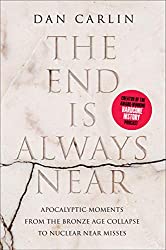
Rating: 7.9/10.
The End Is Always Near: Apocalyptic Moments, from the Bronze Age Collapse to Nuclear Near Misses by Dan Carlin
History book by Dan Carlin, famous for the Hardcore History podcast. This book is a collection of eight loosely-related chapters, mostly related to societies in decline or apocalyptic moments in history, such as the Bronze Age collapse, the decline of the Roman empire, and the possibility of nuclear apocalypse during the Cold War. The writing has a colloquial style similar to the podcast: many details are hidden in the footnotes, and the author often makes analogies to the modern world to explain casually to the reader.
Chapters 3 and 4 talk about the collapse of the ancient Bronze Age civilizations and the Assyrian Empire respectively. The Bronze Age collapse occurred around 1100BC but historians disagree about what happened and why: possible factors include invasions, climate change, warfare, volcanoes, and what likely happened was a systemic collapse where a disruption in one area figured a domino effect that caused the collapse of several other states. The Assyrians were well known for their brutality towards captured enemies and rebels, and controlled much of the Middle East for several centuries until they themselves were conquered by an outside force.
Chapter 5 is about the relationship of the Roman Empire with its neighboring barbarian states, who are responsible for the collapse of the Roman Empire in the 5th century. From the Roman perspective, conquering barbarians was a never-ending task because there will always be another barbarian tribe behind the one they just conquered. Following a series of military defeats, the Romans and Germanic tribes reached a steady state with a border along the Danube river. After centuries of peace, those bordering Germanic tribes acquired a lot of Roman culture, customs and technology, and furthermore, during the later stages of the Roman Empire, Germanic mercenaries, rather than native Roman soldiers, were often hired to battle against other Germanic tribes. The weakened Roman political structure eventually led to its inability to resist barbarian invasions.
The last two chapters are about nuclear weapons: for the first time in history, humans have developed the ability to destroy itself. America was the first to develop nuclear weapons, and during the early stages of the Cold War, there was serious debate about whether to preemptively destroy the Soviets before they develop their own nukes. Eventually the Soviets caught up, and the height of the tension was during the Cuban missile crisis, where we narrowly avoided a nuclear engagement between superpowers. Another controversial debate is whether it is ethical to use force on non-combatants, which was inevitable for large scale nuclear weapons and occurred frequently during airstrikes. An argument can be made that inflicting heavy civilian losses at the beginning of the war could make it short and quick, avoiding a prolonged conflict. In reality though, many weapons were not accurate enough to distinguish civilian vs military targets, so it was a moot point regardless.



